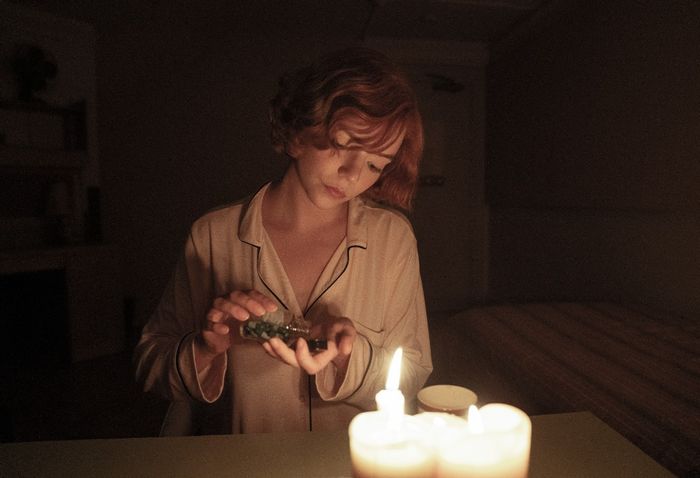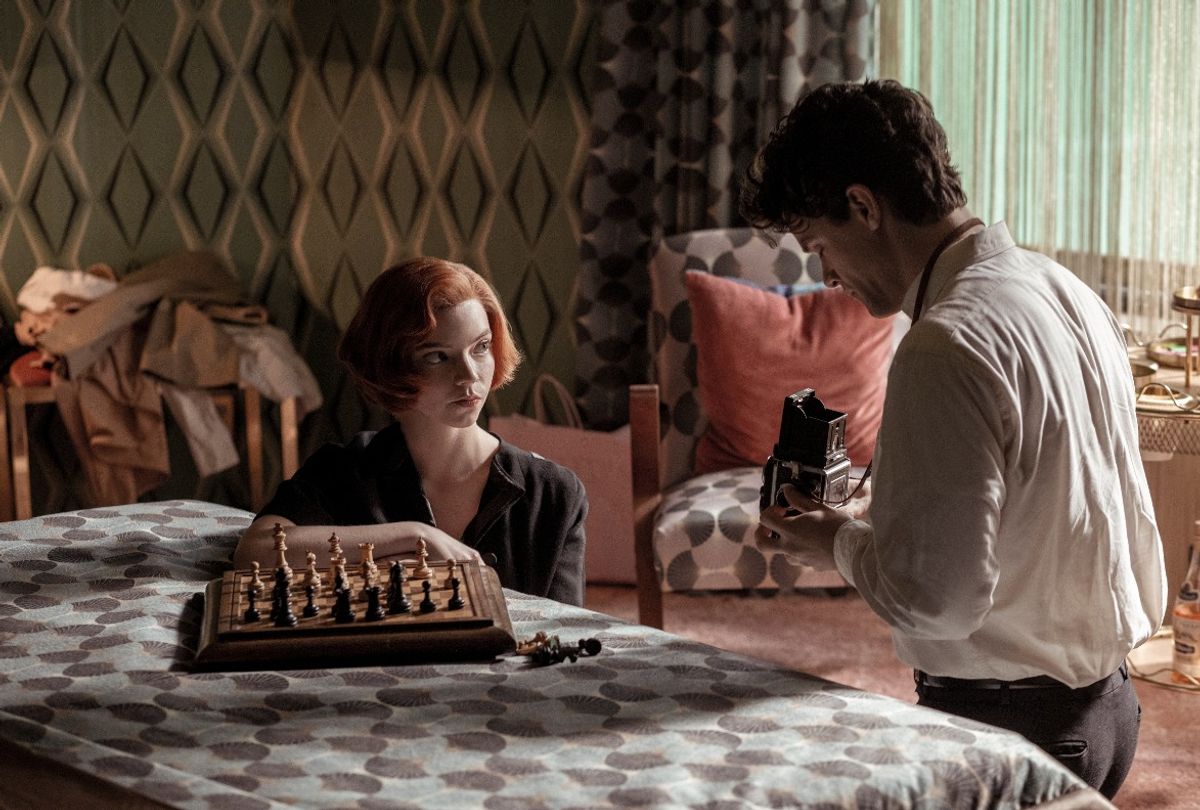"You really are something, you know that?"
In Netflix's limited series "The Queen's Gambit," troubled chess prodigy Beth Harmon — played by "Emma" star Anya Taylor-Joy — receives this compliment from her good-looking opponent Townes (Jacob Fortune-Lloyd) during her first tournament. Even though she's somewhat distracted by his charming demeanor, that doesn't stop her from trouncing him after chasing his pieces around the board.
It's one of numerous suspenseful matches throughout the series, where the dynamic can shift from playful to desperate or lackadaisical to cutthroat in just a few moves. In this scene, Beth handles the pieces reluctantly — unwilling to be the author of Townes' doom — which brings a sweet, flirtatious tone to the game.
"Whatever the energy is of the person that you're playing with, it is a bit of a dance," Taylor-Joy tells Salon. "I love that sequence with Townes because it's the first time that Beth is genuinely conflicted about winning. Like, 'I want to win the more than anything, but you're also so cute. This is making me sad, and I'm confused by it.'"
Chances are "The Queen's Gambit" is the sexiest, most addictive TV show about chess you'll ever watch. Granted, it's probably the only TV show about chess you'll ever watch (sorry, "Endgame"), occupying a space in entertainment where only films occasionally dare to venture.
Written and directed by Scott Frank, and based on Walter Tevis' 1983 novel of the same name, "The Queen's Gambit" begins with nine-year-old Beth in a Kentucky orphanage, where she is raised after her mother's tragic death. There, a taciturn janitor (Bill Camp) introduces her to chess, for which she has an astounding aptitude. After her adoption, Beth's unique Bildungsroman begins in earnest as she travels the country and then the world to earn prize money at chess tourneys and seek the respect from mostly male peers.
Tevis, who also wrote "The Hustler," goes beyond the usual underdog sports narrative for "Queen's Gambit." He draws a line between genius and mental health, giving Beth a host of personal issues that begin in childhood. Not only is she alone in the world, which plays out in her uncertain relationships with men later in life, but in the orphanage she's introduced to tranquilizers. They soon become an addiction that continues into adulthood when she also adds alcohol to the mix. It's your classic tale of sex, drugs, and . . . well, chess.
In the trailer, we see Beth literally falling down drunk, and throughout the series she goes on various benders that interfere with her success in the game and in life. Despite Beth turning to some rather self-destructive coping mechanisms, however, the series never ventures too deep into the darkness.

"[Creator Scott Frank] really gets in a primal way that tragedy has to make you laugh," says executive producer William Horberg. "He doesn't ever want things to get too earnest. I love the sense of humor in this, even when it's pretty dark. Even when there's some heavy stuff going on with these kids [in the orphanage] being dosed with tranquilizers, the way he intercuts that with clips from the movie 'The Robe' where the characters are entering the kingdom of God with the scene of [young Beth] stuffing pills in her mouth — that's pure Scott."
Substance abuse and testing the waters with various men — including characters played by Thomas Brodie-Sangster ("Game of Thrones") and "Harry Potter" alum Harry Melling — are just distractions, however, from Beth's one true love: chess. And the series sets up the matches and shoots the scenes cleverly so that even an audience without a deep understanding of the rules or nuances of chess will find it as enthralling as Beth does.
Part of the series' success in translating chess for viewers comes from Tevis. He was a devoted C-class player who constructed the novel's realistic games with the help of U.S. chess master Bruce Pandolfini, who also consulted on this series and the film "Searching for Bobby Fischer." Much of the dialogue and gameplay has been lifted straight from the page to the screen.
Pandolfini also coached the actors on how to play convincingly. It's not just about moving the pieces but how one uses the hands, the posture, the psych-out body language. Beth plays against grandmasters, former child prodigies like herself, and world champions. Each of these actors had to look as if they'd been playing their whole lives.
"And then even further, Bruce introduced Scott and I to Garry Kasparov, who's maybe the greatest chess player of all time. Garry had lived the life of our protagonist because he was a child chess prodigy, who was growing up in the Cold War and was roughly the same age as Beth Harmon's character in the book," said Horberg.
"He had a whole other dimension of really interesting stuff to share with us outside of the book, just in terms of what was it like when you were seven or eight in the Soviet Union? Your relationship with your family and your peers and the adults and the KGB? How did it work when you were going to play tournaments?"

The lynchpin of the series of course is Taylor-Joy, who's often been acclaimed for the non-verbal aspects of her performances, from her creepy debut in "The Witch" to the surprisingly visceral adaptation of Jane Austen's "Emma." Much is made of her large, expressive eyes, but never before have they been as essential to the storytelling as when she plays chess, drawing the viewers into the gameplay with every stare or flicker. For Beth, these matches are life or death, and those stakes had to be communicated.
"It was important for me to understand the serious chess because I know the people that really love this sport," said Taylor-Joy, who was a novice going into filming. "Knowing the theory was important. However, knowing the theory and then executing it are two very different things."
Memorizing moves for a filmed match is just the first step of the challenge. As a genius, Beth is often asked to play simultaneous matches against multiple people, shifting from board to board, one move after another. Even more difficult is a scene where she plays simultaneously against three different opponents, but this time, it's speed chess.
"That's actually some of my favorite sequences in the entirety of the show, because they were so much fun," said Taylor-Joy. "With the amount of games that I had to play, the only way that it was feasible without me literally driving myself insane, because I am in every scene essentially of this whole thing, I would learn the sequences five minutes prior. And I just have to thank my short term memory for that, like, dance choreography for my fingers.
"It just became a competitive thing within myself. 'OK, how quickly can I learn how many moves to play over three different boards? And then how fast can I do that?' One of my favorite photographs ever taken is me on set, Scott just snapped a picture of me the second that the first take of speed chess is done, and it's like pure joy. But I was so happy and proud of myself."
"The Queen's Gambit" is currently streaming on Netflix.

Shares